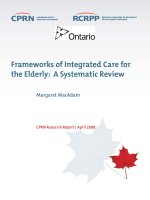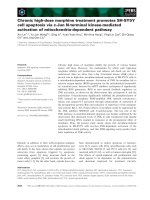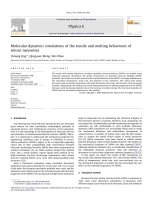behaviours-of-concern-care-pathway-v3-4
Bạn đang xem bản rút gọn của tài liệu. Xem và tải ngay bản đầy đủ của tài liệu tại đây (705.87 KB, 56 trang )
Specialist Services Division
Care Pathway For Behaviours of Concern
Version dates September 2016
Original document developed by Dr Samantha Harris, Consultant Clinical Psychologist
In collaboration with:
Dr Peter Speight, Consultant Psychiatrist
Mrs B Browne, Parent and Expert by experience
Mr K & Mrs L Tomlin, Parent and Expert by experience
Based, with permission, on a document written by Dr Ursula McCann, for Northamptonshire Partnership Foundation Trust, 2008.
Page | 1
Contents
Section 1
Section
Care Pathway Overview
Page
3
Introduction
3
Summary Flowchart of Care Pathway
4
Part 2 Service Pathway
5
Step 1: Referral into CCG Locality based Community Team
6
Step 2: Allocation of referral
8
Step 3: Assessment
9
Step 4: Formulation
16
Step 5: Intervention
20
Step 6: Evaluation and Review
31
Step 7: Discharge
34
References
35
Part 3 Appendices
39
Appendix 1
Care Pathway Audit Tool
Appendix 2
Comprehensive Care Pathway Flowchart
Appendix 3
Other assessments available
Appendix 4
ABC Charts and guidance
Appendix 5
Example of self monitoring sheet
Appendix 6
Measuring Outcomes of PBS
Page | 2
1. Care Pathway Overview
Introduction
NICE Guideline NG11 (2015) describes a clear approach to working with people who show
behaviours of concern. It explains that some people with a learning disability display
behaviour that challenges, although goes on to state that this is not a diagnosis per se, but
the behaviour is a challenge to services, family members or carers. The Royal College of
Psychiatrists, British Psychological Society and Royal College of Speech and Language
Therapists (2007) defined behaviour that challenges as,
“…… when it is of such an intensity, frequency or duration as to threaten the
quality of life and/or the physical safety of the individual or others and is likely to
lead to responses that are restrictive, aversive or result in exclusion.”
This definition and the NICE guideline (2015) suggest that behaviours that challenge are
constructed socially, often serving a purpose for the individual and resulting from an
interaction between personal and environmental factors.
A Care Pathway is defined as “locally-agreed, multi-disciplinary practice based on
guidelines and evidence, where available, for a specific client group” (Overill, 1998). This
Care Pathway aims to develop a multi disciplinary approach to working with referrals
where the primary concern is a behavior that challenges. It is based on two main
documents; the NICE Guidance (2015) and the The Royal College of Psychiatrists, British
Psychological Society and Royal College of Speech and Language Therapists’ report, ‘A
Unified Approach’ (2007).
A Positive Behavioural Support Framework is followed, in line with NICE and Department
of Health Guidance (Positive and Proactive Care: reducing the need for restrictive
interventions, 2014). Appendix 1 outlines an audit tool for this care pathway to encourage
self evaluation of the process. Appendix 2 shows a comprehensive flowchart of the
pathway.
Page | 3
Summary Flowchart of Care Pathway for Appropriate Referrals
Referral into the Community Team for People with a Learning Disability
And Initial Triage Assessment
Allocation of Referral
Referral stays
with Community
Team
Allocated to the
appropriate members of
the Team
High urgency;
Referral to CHAT
Team
ASSESSMENT
FORMULATION
Different type of
professional input
may be required
Different care
pathway may be
indicated
INTERVENTION
MONITOR & EVALUATE
DISCHARGE
Page | 4
2. Service Pathway
Step 1. Referral pathway
Step 2. Allocation
Step 3. Assessment
Step 4. Formulation
Step 5. Intervention
Step 6. Monitor & Evaluate
Step 7. Discharge
Page | 5
Step 1.
Referral into CCG Locality Community Team
The Locality Community Teams operate an open referral system, thus accept referrals
from a wide variety of sources including: self-referrals; family carers, support agencies;
general practitioners; education professionals; social services professionals, and so on 1.
For a referral to be accepted, the individual must:
•
Be 18 years or over;
•
Have a learning disability as defined in NICE Guidance NG11 (i.e. significantly reduced
intellectual ability , usually an IQ of less than 70, significant impairment of adaptive
functioning and onset in childhood);
•
Be an ordinary resident of Lincolnshire, with a Lincolnshire GP;
•
Have a health need which is commissioned by Lincolnshire SW CCG, as part of the
service agreement with Lincolnshire Partnership NHS Foundation Trust (LPFT).
In addition, the service user must be in agreement with the referral, when they have
capacity to do so. If they lack the capacity to agree, LPFT staff will be required to
complete a Mental Capacity Act assessment during the first appointment, and will only
proceed with the referral if it is in the Best Interests of the person concerned.
New referrals are received via the Trust’s Single Point of Access (SPA). They are screened
daily by the Team Co-ordinators (or allocated deputy). The Crisis Home Assessment and
Treatment team provides a service to support individuals with significant, high risk,
behaviours of concern in their home environment, which could ultimately lead to a
hospital admission. This includes supported living, residential and nursing home
placements, as well as family homes. A separate care pathway is available for these
referrals. As referrals are screened, any CHAT referrals are forwarded directly to the CHAT
team. If it is felt the CHAT team are required by any professional working with individuals
at other stages of the care pathway, internal transfers occur, and the referred person joins
the CHAT care pathway.
LPFT are committed to providing accessible information about the services it provides, to all who may wish
to refer. This information can also be found on the Trust’s website.
1
Page | 6
Each Community Team comprises of a variety of health professionals including:
•
Clinical Psychologists;
•
Psychiatrists;
•
Speech and Language Therapists;
•
Occupational Therapists;
•
Physiotherapists;
•
Behavioural Support Specialists;
•
Mental Health and Autism Spectrum Condition Liaison Workers;
•
Physical and Acute Healthcare Liaison Workers;
•
Intervention Assistants;
•
Administrative staff.
.
Page | 7
Step 2.
Allocation of referral
Urgent referrals, which require the Community Home Assessment and Treatment service
(CHAT) are forwarded to that service immediately. For all new, non urgent referrals, an
initial telephone triage assessment is completed within two weeks of the original referral
being received. This assessment confirms eligibility (which, in some cases, may require
further assessment from psychology and/ or occupational therapy), clarifies the reason
for referral and establishes the priority level of the referral, whilst also conducting a
preliminary risk assessment. Information is also gathered about previous contact with
services, support needs, communication ability and previous interventions. This
information is taken to the weekly Multi-Disciplinary Team meeting, to enable allocation
to the appropriate professional.
Referral stays with Locality Community Team
If it is felt that the referral is appropriate for a Positive Behavioural Support based
assessment, formulation and intervention, the referral remains within the Community
Team. The referral will therefore be allocated to an appropriate team member. Dependent
upon level of need and risk, the allocated worker may consider that individual or joint
work is required.
Page | 8
Step 3.
Assessment
Goal of assessment
It is expected that the assessment will provide useful, appropriate and sufficient
information to assist in the development of a clear clinical formulation. The aim of the
clinical formulation is to understand the factors which have led to the development of the
behaviours of concern, what causes them and what maintains them. This includes the
strengths of the person and their carers, and any factors which prevent difficulties arising,
for the individual. Suggested formal assessments which may be useful, depending upon
the needs of the person are listed in Appendix 3. Some of these may also be used on a
case by case basis as outcome measures, as advised by the British Psychological Society
(2014).
The assessment also provides a baseline against which the effectiveness of any
intervention can be assessed, particularly with regard to the individual’s quality of life. At
this point it is essential to support the development of the goals of any intervention,
which the person and their carers feel are important, relevant and measurable. The goals
of the intervention will be part of the outcome measurement, to monitor the
effectiveness of interventions. This information is reported to commissioners.
Preliminary Triage Assessment
The assessment should begin with a comprehensive review of any available background
information. It is important that such a review identifies any previous interventions, what
they entailed, whether they were successful, and if not, why they failed. The following
information should be gathered from relevant documented notes:
•
Family history
•
Support needs and support network
•
Life events both positive and negative
•
Physical difficulties or health issues
Page | 9
•
Diagnoses
•
Communication ability
•
Skills and limitations
This background information should be obtained from the clinical notes (requesting
historical notes from archives if necessary) and through initial discussions with the
referrer, support providers (whether family or paid organisations/ individuals) and any
other Community Team members who know the person.
Risk Assessment
The LPFT Clinical Risk Assessment and Formulation tool must be completed for each
referral. This uses the five Ps framework to ascertain the risk to client and others, and to
develop a formulation of the risk factors. This leads to the development of risk
management systems, which includes preventative strategies and positive risk taking.
Physical Health Assessment
Physical conditions, including pain, are well established as significant contributors to the
development and maintenance of behaviours of concern in people with Learning
Disabilities. Therefore, it is important that this is assessed as part of the comprehensive
assessment process. This could involve the use of the OK Health Check (Matthews 1997)
which is an evidence-based checklist of health indicators that provides a systematic
approach to assessing the health needs of people with learning disabilities.
Mental Health Assessment
Behaviours of concern may also arise due to mental illness in people with a learning
disability. The RCP, PBS and RCSaLT report, Challenging behaviour: a unified approach
(2007) outlined four ways in which mental health issues may be associated with
behaviours that present a challenge;
Page | 10
1. Behaviour of concern may be the symptomatic presentation of a mental disorder. For
example, some forms of self-injurious behaviour may constitute an atypical
presentation of obsessive–compulsive disorder among people with severe learning
disability.
2. Behaviour may be a secondary feature of a psychiatric disorder. For example, somatic
symptoms such as headache, abdominal pain, agitation, and disturbances of
physiological functions such as sleep, appetite and bowel movements may occur in
people with severe learning disabilities who are depressed or have experienced
trauma and unable to express their feelings verbally.
3. The presence of a mental illness might establish the conditions for certain behavioural
responses that become reinforced and maintained by other environmental or internal
factors. Apathy and low motivation in depression, for example, may be associated
with an unwillingness to participate in educational or social activities. The avoidance
of these activities may be negatively reinforcing, or the comfort of remaining at home
with carers may positively reinforce this withdrawal from previous activities. Previous
association of behaviours that challenge with positively or negatively reinforcing
events may lead to an increase in these behaviours at times of mental ill health.
4. Medication for the treatment of mental illnesses may result in unwanted effects.
These may include: akathisia from neuroleptics, disinhibition from benzodiazepines,
induced anxiety, excessive sedation and constipation from selective serotonin
reuptake inhibitors (SSRI).
The assessment and diagnosis of mental health issues in people with learning disabilities
can be complex and difficult. However, changes in behaviour, where clear symptoms and
signs of psychiatric disorder are not evident, should not be assumed to be due to a
psychiatric disorder. For example, an adult with learning disabilities who appears to be
having a conversation with themselves or is raising their fist at unseen ‘objects’ should not
be assumed to be experiencing hallucinations unless there is further, more detailed
Page | 11
evidence that can distinguish this as a hallucinatory phenomenon rather than a behaviour
that is consistent with the individual’s cognitive or developmental level.
Clinicians and carers should also be aware of the phenomenon of ‘diagnostic
overshadowing’ which is the tendency to attribute behavioural patterns to the person’s
pre-existing learning disability, thereby failing to consider the presence of a psychiatric
disorder superimposed on the person’s learning disability.
Defining the behaviours of concern
Obtaining the perspectives of carers/parents/professionals who observe the behaviours
labelled as challenging.
Guidelines from the British Psychological Society (2004) emphasise that behaviours of
concern are socially defined, that is, they are defined to be challenging by virtue of
another person’s perspective of, or reaction to, those behaviours.
With that in mind, it is important to explore the meaning of the behaviour with the
individuals themselves, and to examine how the behaviour is understood by their family,
friends and supporters.
In working with significant others, the following questions often provide helpful
information:
•
What exactly are the behaviours that require intervention? Different people may
have different views about this.
•
What is the impact of these behaviours? What does it feel like to experience or
witness these behaviours? What do people feel to be the cause of the behaviours?
•
When are the behaviours more and less likely to happen? Does everyone agree?
•
How long do the behaviours last and how intense are they?
Page | 12
Appendix 3 includes an example of a structured interview to provide information on the
impact and contextual factors of behaviours causing concern.
Observations
Direct observations, are recommended by the British Psychological Society (BPS) as the
most accurate way of assessing the behaviours of concern in order to develop a
comprehensive formulation. The BPS recommends that either psychologists, or those
appropriately trained in behavioural observations, carry out such observations. Consent
procedures are important when carrying out observations given the potential
infringement of privacy. The principles of the Mental Capacity Act (2005) may be followed
if the person lacks the capacity to make an informed decision.
Important factors to consider when conducting observations are:
•
Development of a clear, objective description of the behaviour
•
Impact of the behaviours; and on whom
•
Frequency/ severity and duration of the behaviours
•
The response of others – what typically happens after the behaviour is
displayed?
•
What prevents behavioural difficulties for the individual; when they are
presenting as content and engaged; how is this achieved and maintained?
•
Assessment of the environment, including:
o Quality of the physical environment
o Level of stimulation in the environment
o Number of people present, interpersonal space, needs of others relative to the
individual (e.g. do they have to deal with others shouting near them?)
o Access to services: whether provided; not provided but required; not provided
but desirable
o Staffing – levels, support for staff, supervision of staff, skill mix, gender issues,
key-worker system.
Page | 13
It is also important to be aware of the way in which the observer may alter the
environment, and may have an impact on the behaviour of the person being observed.
For this reason, observations are not always the most effective method of obtaining the
data required.
ABC charts can be a method of obtaining data, although reliability is often an issue of
concern. An example of such charts and advice about how to use them is included in
Appendix 4.
The BPS also recommends that, where possible, people with Learning Disabilities should
be encouraged to, and receive support in, monitoring their own behaviour. This can take
the form of self recording (see Appendix 5 for example).
Further considerations within assessment
The assessment should also consider the following information, when required:
•
The possible need for a medication review
•
Assessment of the need for CPA (Care Programme Approach)
•
Assessment of the need for Adult or Child Safeguarding procedures. People who
present with behaviours that challenge are at greater risk of abuse than others
(e.g. White, Holland, Marsland & Oakes, 2003)
•
Psychometric assessments when indicated (e.g. Vineland, ABAS, WAIS, mini PASADD, see Appendix 3)
•
Diversity and equality issues
•
Assessment of motivation to change, dependent upon the likely plan of
intervention, (i.e. the motivation of the individual to engage if direct work is
indicated, staff or family if indirect work is indicated).
•
Sensory assessments, (see Appendix 3) to support understanding of sensory needs
and preferences, which may be resulting in behaviours of concern.
Page | 14
Communication of the assessment findings is a crucial step. This requires due
consideration of the format of the information provided in the report, and how the
assessment is fed back to the carers, the person with learning disabilities, and/or other
relevant parties. This must take into account the situation and context; as an example, it is
very easy for family carers to feel guilt and blame for the behaviours of concern. It should
be acknowledged that situations are complex, and families are often simply trying to do
their best in a difficult and exhausting situation.
Page | 15
Step 4.
Formulation
Developing a useful and theoretically based clinical formulation about the behaviours of
concern is a specialised skill that requires specialist training and supervision from an
appropriately trained professional. This is not to discourage less experienced individuals
from working on formulation skills, but they should always seek supervision and guidance
from an appropriately skilled clinician, particularly before sharing the formulation with
others and before using it to develop the plan of intervention.
The five Ps Framework can be a useful method of developing a clinical formulation. It is
not the only framework available, and advice should be obtained from the appropriately
trained professional regarding other, more useful and meaningful methods of developing
a person centred clinical formulation. However, the five Ps framework is a trans
theoretical framework (i.e. can be interpreted using a number of psychological and social
models of human behaviour, such as Behavioural, Cognitive Behavioural and Attachment
Theory). The following section provides some helpful questions that can help identify each
element. It should be noted that when asking questions to elicit the required information,
sensitivity is required. The questions are likely to provoke a number of thoughts and
emotions in the respondent, which may be difficult for them to experience, particularly if
they are feeling anxious, guilty, distressed and vulnerable.
Presenting Problems
•
What is causing the most concern?
•
What do people want to change?
•
Which behaviours cause problems for people? What exactly are these behaviours? In
other words, what does the person do or say (or fail to do or say) which causes
problems for others and/or themselves?
•
What is the most concerning behaviour, e.g. the behaviour that the carers or person
involved describe using the most emotive or vivid language?
Page | 16
•
Is there a recurring interaction which the person has with other people which causes
problems? Why does the interaction cause problems? What happens immediately
after the interaction?
•
Remember that there may be one set of presenting problems as far as carers are
concerned, and quite another as far as the client is concerned!
Predisposing factors
•
What limitations does the person have?
•
Which limitations may have led to the person developing the behaviours of concern?
•
Are there any significant experiences in the person’s past or in the system that may
have an influence on the current situation. For example, someone who gets very
anxious (presenting problem) when visitors come to their house (precipitating factor)
may have experienced abuse in the past (predisposing factor).
•
How might having a Learning Disability be a risk factor? Evidence suggests, for
example, that people with Learning Disabilities are more likely to have mental health
problems (e.g. Cooper & Bailey, 2001).
•
Consider the following:
o the influences of the person’s relationship with their main carer and their
early caring experiences;
o any significant life events, remembering that events which some might not
consider to be significant (e.g. a visit to the dentist); may actually be very
traumatic for someone with a Learning Disability,
o any significant disabilities or functional impairments (e.g. problems with
motor co-ordination, communication difficulties, etc.);
o any sensory needs/ preferences;
o current developmental stage;
o particular gaps in knowledge (e.g. sexual understanding) etc;
o the effect of the weather, or seasonal variances in behavioural
presentations.
Page | 17
•
Is the person unable to do something they always used to do? What is it that they can
no longer do? Why does this cause problems (and to whom)?
•
Is there a particular problematic relationship? Who does the relationship involve and
what is it that happens between these people that causes anxiety/ stress/ depression/
isolation, etc?
Precipitating factors
•
Is there a particular person, place, time of day or activity (or combination thereof)
that often (but not necessarily always) leads to the presenting problem?
•
When considering all the different situations in which the presenting problem occurs,
are there any similar factors that might lead to the occurrence of the presenting
problem?
•
Are there any particular thoughts, feelings, desires or beliefs which may be
contributing to the presenting problem, eg someone believes that they have been
criticised, or bullied, or feels unsafe.
•
Is there something, which, when it occurs, always results in the problems happening,
e.g. “every time we try to go out Fred always gets upset…”.
•
Do the difficulties tend to occur when the person is alone? Although this may lead
others to believe that the behaviour has no ‘triggers’, being alone may be associated
with boredom, anxiety, lack of structure, sensory needs/ preferences, under
stimulation, etc.
Perpetuating factors
•
Is the behaviour being reinforced (positively or negatively)?
•
Is there any evidence of avoidance either within the person , or the person’s
relationship with someone else, or within the wider system (family, carers,
professionals)?
Page | 18
•
Does the response to the problems lead to further difficulties that perpetuate the
problem? For example, someone may avoid an anxiety provoking situation (crowds,
hospitals etc), thereby never facing and resolving the problem.
•
How is the presenting problem perceived by others, and how does this affect the way
in which they interact with the person displaying the challenging behaviour?
•
What response do people have to the person/system/issues presented?
Protective factors
•
What strengths does the person have?
•
What are their skills? What do they enjoy?
•
When they are presenting as content and engaged, what is happening to achieve this
and maintain it?
•
Who are they close to? What are the characteristics of their positive relationships?
How do they communicate with others?
•
What strategies prevent the behaviours of concern occurring?
Page | 19
Step 5.
Intervention
Planning the Intervention
Before commencing with any intervention, it is important to bring together all of the
elements of assessment into a coherent and concise, evidence based, intervention plan.
This plan should be developed and agreed by the multidisciplinary team, the individual
(when possible, following the principles of the MCA, 2007) and carers. The relevant roles
and responsibilities of all involved, including a named lead professional and the process
for coordination, should be clarified, documented and agreed.
Interventions must be delivered in a person-centred context, acting in ways that support
equality and value diversity. While the detailed assessment and formulation process
should result in clear intervention strategies, these must be tailored to the individual,
their personal characteristics, culture & ethnicity, religion, gender, age, disability, sexual
orientation, environment and available resources for support.
Multi-agency and multidisciplinary involvement should occur in close partnership with
families and other carers. Detailed information concerning the nature and outcome of
previous interventions should be obtained and taken into account.
Ethical issues and priorities
Managing risk
Where aggression or self-injurious behaviour presents a serious risk to the person or
others, effective and ethical reactive strategies for managing the behaviour as it happens
(or seems about to happen) need to be in place as a matter of urgency. The team has a
responsibility to check that such a strategy is in place and that it is being used ethically.
LPFT team members will not make use of, and cannot advise on, restrictive physical
interventions in a community setting. If this type of intervention may be required as a
Page | 20
last resort, the carers have a duty to ensure any training or advice is compliant with the
British Institute for Learning Disabilities (BILD) code of practice.
Prevention of abuse
No intervention for behaviours of concern should be abusive. The team must not use
interventions, which constitute cruel, inhuman or degrading treatment or those which
rely on punishment regimes. Team members have a duty to report colleagues/ carers
who are using such interventions. When abuse is suspected, local policies (e.g. safeguarding vulnerable adults, inter-agency policy on child protection) must be consulted and
followed.
Reactive Strategies
These interventions focus on containment of behaviours that present a risk of harm or
injury to the person, or others, at the time the behaviours occur or are about to occur.
An effective and ethical reactive strategy for managing behaviours of concern should be
devised on a case-by-case basis and needs to be based on an understanding of the
individual. The information collected in the functional assessment should be used to
guide the choice of strategy.
Where there is a need to have a strategy in place quickly, because of a high and
immediate risk of harm to the person or others, hypotheses about the function of the
behaviour should be collected from people who know the person well (families/ carers/
staff) and from available records. This should be used to guide the choice of strategy; with
the understanding that this is an interim arrangement and is to be reviewed as soon as a
thorough clinical formulation can be developed.
Reactive strategies are designed to deal with specific incidents. Non-physical reactive
strategies, which may be effective, include, but are not limited to:
Page | 21
•
Not responding to the behavior of concern (which does not mean ignoring the person
– simply the behavior)
•
Reinforcing alternative, more positive and adaptive behaviours
•
Removing or reducing demands on the individual
•
Diversion to a reinforcing, interesting or compelling event or activity
•
Low arousal approaches where others stay calm, quiet and non-threatening and try to
avoid escalating arousal and the risk of physical violence.
Proactive/Preventative Strategies
These strategies focus on the prevention, reduction or elimination of the behaviours of
concern through planned interventions. Interventions are values led, and
multicomponent, with a focus on:
•
Promotion of new skills, to support independence
•
Improving quality of life of the individual
•
Understanding the meaning of any behaviours of concern
•
Changing the environment and systems of support, to reduce the likelihood that
individuals will resort to behaviours that challenge.
These strategies may therefore reduce the frequency, intensity or duration of the
behaviours of concern; but will certainly lead to an improved quality of life.
Any specific intervention strategies should focus on the chosen target for change and
should follow on logically from the functional assessment.
Choice of strategy should be based on the following criteria:
•
Capacity for long term maintenance
•
Capacity for generalization
•
Ethical considerations
•
Social validity – acceptance to families, staff, the general public
•
Ease of use or application
Page | 22
•
Other benefits for the person with learning disabilities
•
Known effectiveness in reducing or preventing challenging behaviour.
Psychotherapeutic Interventions
The underlying aetiology of challenging behaviour may relate to (for example):
•
psychological trauma, such as: a past, or ongoing history of abuse; losses or
bereavement (Hollins & Esterhuyzen, 1997);
•
problems in sexuality and intimate relationships;
•
intra-familial, interpersonal and/or intra-personal conflict;
•
difficulties in monitoring, regulating and changing emotions or behavioural coping
strategies.
While interventions may focus initially on the immediacy of the challenges being
presented, it is also essential to understand and work to resolve some of these underlying
conflicts, traumas or psychological issues.
For many years, psychotherapeutic interventions were denied to people with learning
disabilities, but they are increasingly being accepted as applicable and
effective (Royal College of Psychiatrists, 2003; British Psychological Society,
2016). A range of Psychological approaches may be employed, such as
psychodynamic, cognitive behavioural, systemic, integrated (e.g. Dialectical
Behaviour Therapy, Cognitive Analytic Therapy). Although much of the
current evidence-base relates to people with mild learning disabilities, many
clinicians are adapting in particular, psychodynamic, cognitively based and
integrative interventions in order to make them more available to people
with more significant learning disabilities.
Page | 23
Psychodynamic approaches may be effective in increasing self-esteem and reducing
psychological distress, interpersonal problems and offending behaviour
(Hollins & Sinason, 2000; Beail, 2003; Wilner, 2005). Cognitive behavioural
approaches, either individually or in groups, have been applied to difficulties
arising from anxiety, anger, aggression and offending. When behavior that
challenges appear to be a response to a person’s psychological distress or a
mental health problem, this needs to be treated by the most effective means
possible. Psychological problems such as anxiety, phobias and depression
can be effectively reduced with cognitive behaviour therapy in people with
learning disabilities who have the motivation and skills necessary for
cognitive techniques.
Psycho-educational approaches or skills training
Where behaviours that challenge appear to be a response to stressors in the environment,
people with learning disabilities can be taught alternative ways of coping or problem
solving. For example, interventions which support the development of appropriate
responses to anger, can be effective. These can often be delivered in a group intervention,
where people can share experiences and learn from peers. Group interventions should be
delivered by competent, trained staff who can deviate from prepared session plans to
meet the needs of all individuals in the group. Any named client who cannot access
groups, due to either their practical circumstances (e.g. rural accommodation and poor
transport links) or their cognitive, developmental and emotional level, should be offered
individual therapy.
Positive Programming
One of the central components of positive behavioural support is to enable the person to
engage in meaningful occupation, activities and relationships. Changes in a person’s
quality of life are both an intervention and a measure of the effectiveness of an
intervention. Interventions are frequently delivered through, and in partnership with, a
range of different mediators (families, support workers etc). Mediators need to be both
Page | 24
skilled in the delivery of positive interventions (i.e. interventions that promote wellbeing,
quality of life and meaningful occupation/ engagement in activity), as well as organized
and supported in such ways that they can support people to develop and maintain a
meaningful life.
Specific approaches to ‘positive programming’ may be required if mediators are to be
supported to deliver positive interventions. One such approach is active support (Jones et
al, 1999) a package of procedures that includes activity planning, support planning and
training, to enable carers to support engagement in meaningful activity, or meaningful
occupation. Such approaches have been shown to increase the quality of assistance that
individuals receive and to improve their engagement in everyday activities.
Positive environmental change
There are a number of preventative strategies, which focus on changing the environment.
These include positive curriculum design, increasing choice and environmental
enrichment. Creating an environment which is more adapted to the person’s needs and
preferences can reduce behaviours of concern as well as being beneficial in its own right.
Differential reinforcement
It is possible to reduce the incidences of behaviours that challenge by reinforcing (and
thereby increasing the rate of) other behaviours. This is called differential reinforcement.
The most commonly used procedure is Differential Reinforcement of Other behaviour
(DRO), in which any behaviours other than the challenging ones are reinforced (i.e. the
person receives reinforcement for not engaging in the “challenging” behaviour). Other
differential reinforcement strategies target specific behaviours that are Alternative to
(DRA), or Incompatible with (DRI), the behaviours that challenge. These strategies are
more likely to succeed if the new behaviours require less effort than the behavior that
challenges, or if the reinforcers for them are more immediate and powerful.
Extinction
Extinction is the non reinforcement of a previously reinforced behaviour. The effects of
exctinction are well documented , and always result in a sharp increase in the frequency
Page | 25









